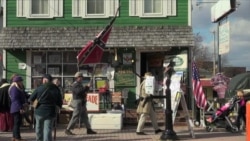The echo of the American Civil War of the 1860s still resonates in the United States. The descendants of those who made history come together every year to remember the greatest battles and to discuss the military campaigns of the war that almost divided this nation.
The re-enactment of one of the war's most significant battles takes place each year on the streets of the small Pennsylvania town of Gettysburg.
To the naked eye, the view of this little Pennsylvania town looks like a flashback to the past. The only difference is these soldiers and officers of the Union and Confederate armies are not on a battlefield, but peacefully discussing the military campaign of 1863 that took place over a three-day period here, 150 years ago.
The people who do this call it "living history." They come together every year to re-create and commemorate the battle of Gettysburg.
Living history
Each re-enactor has a role. We met the famous Confederate General Robert E. Lee. And also the heroes of the battle of Gettysburg, the regimental and battalion commanders, and the ordinary soldiers from both the Union and Confederate armies.
President Abraham Lincoln of course is center stage. In this interview, he repeats the message of his famous "Gettysburg address" -- delivered at the dedication of a cemetery four-and-a-half months after the battle.
"This nation, under God, shall have a new birth of freedom, and that government of the people, by the people, for the people, shall not perish from the earth," said the actor portraying Lincoln.
Many participants in this reenactment say the battle of Gettysburg -- one of the bloodiest battles of the war -- decided the future of the United States and preserved the country as the founding fathers had designed it -- united and strong.
"The Eagle flag has a banner that says in Latin 'E pluribus unum', which means 'Out of many, one'. That is what we are. We are a lot of people from different countries in one nation," said one of the re-enactors.
Confederate troops advancing on Gettysburg hoped to defeat the Union forces, take Washington and force the president to recognize the rights of the Southern states. Instead, they were forced to retreat.
Standing united
The Civil War is largely seen as a dispute over slavery. But there was also disagreement on other issues -- such as taxes, tariffs and internal improvements, as well as states’ rights versus federal power.
Re-enactor Jim Getty said he thinks that even if the South had won, the country eventually would have come back together.
"I think by now we would be one nation. We would have reunited by World War I and World War II. We would have settled our differences shortly after the war. We could not remain divided and survive," said Getty.
For many Americans, historical reconstructions like these are not just a hobby, but also an opportunity to pay tribute to their ancestors, to remember the heroes who fought to create present-day America.
And here in a small-town -- Gettysburg, Pennsylvania -- the descendants of those who made history -- on both sides -- are marching down the main street in one united column.






